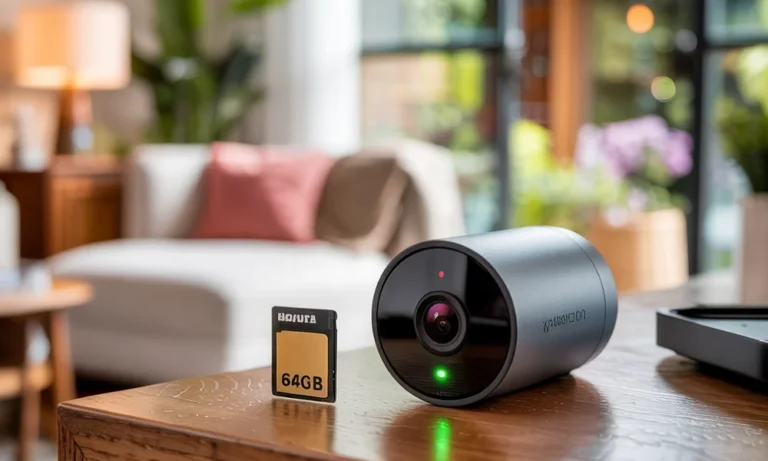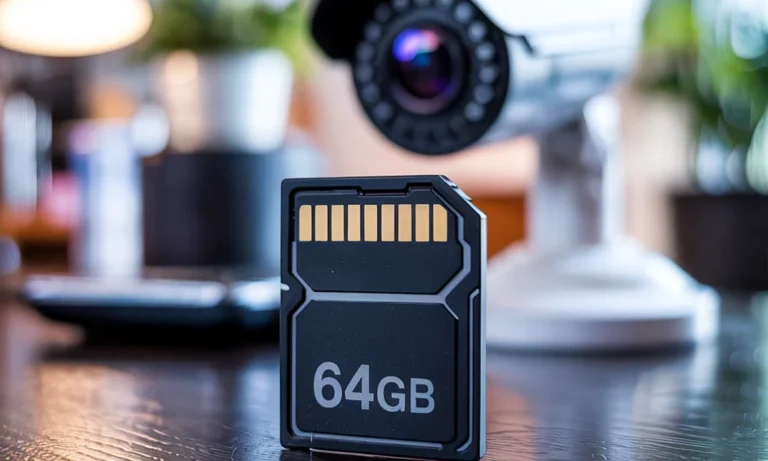What size TF card for home security camera you need depends largely on how much footage you plan to store and the resolution of your video recordings. Storage size is a crucial consideration for home security cameras because it directly impacts how long your camera can retain video footage before it starts overwriting old files.
Whether you’re monitoring your property for safety or just checking in on pets while you’re away, having enough space to store continuous or motion-triggered recordings is essential. A TF card, also known as a TransFlash or microSD card, plays a key role in modern security systems by offering a compact, removable storage solution that’s easy to upgrade or replace. Choosing the right size ensures your camera system operates efficiently without losing important footage.
What is a TF Card?

A TF card, short for TransFlash card, is a type of removable flash memory card used to store data such as photos, videos, music, and documents. Originally introduced by SanDisk in 2004, the TransFlash card was later adopted by the SD Association and rebranded as microSD. Despite this change, many manufacturers and consumers still refer to them as TF cards.
Origin of TransFlash Cards
SanDisk developed TransFlash, the smallest memory card format available at the time. It was designed for use in mobile devices where compact storage solutions were essential. Shortly after its release, the SD Association standardized the format, officially naming it microSD, though the original term “TF card” is still commonly used especially in certain regions and product descriptions.
TF Card vs. microSD Card: What’s the Difference?
In practical terms, there is no significant difference between a TF card and a microSD card. Both formats share the same size (15mm × 11mm × 1mm), functionality, and are physically interchangeable. However, there are a few minor distinctions worth noting:
- Branding: “TF card” was the original name used by SanDisk, while “microSD” is the official term standardized by the SD Association.
- Advanced Features: Modern microSD cards may support additional features like SDIO (Secure Digital Input Output), which aren’t typically supported by older TF cards.
Despite these subtle differences, today the terms TF card and microSD card are often used interchangeably.
Common Uses of TF Cards
TF cards are widely used in electronic devices that require portable storage. Some common applications include:
- Smartphones and tablets – For storing apps, photos, and videos.
- Drones – To record high-resolution aerial footage.
- Gaming consoles – To expand storage for downloadable content.
- GPS devices – For storing maps and location data.
- Cameras – Especially action cameras and dash cams that require compact, high-speed storage.
TF Card for Camera: Practical Applications
When it comes to digital imaging, using a TF card for camera storage is incredibly common. Many camera TF card slots are designed to accommodate microSD/TF cards due to their compact size and ability to handle large file sizes at fast write speeds. Whether you’re using a GoPro, trail camera, or a dash cam, a reliable TF card is essential for smooth video recording and high-resolution image capture.
Use of TF Cards in Home Security Systems
TF cards are also widely used in home security systems, particularly in smart surveillance cameras. Many modern security cameras come with a built-in TF card slot, allowing for:
- Local video storage – Recording footage directly to the card without the need for cloud storage.
- Loop recording – Automatically overwriting the oldest footage when the card is full.
- Easy retrieval – Removing the camera TF card to view footage on another device.
YOu can also read about How Long Do Security Cameras Keep Footage.
What Size TF Card for Home Security Camera?
Choosing the right TF card size for your home security camera is essential for ensuring you have enough storage space for video recordings, while maintaining the quality and reliability of your footage. The size of the TF card directly affects how long your camera can retain video recordings and at what quality.
How TF Card Size Affects Video Retention and Quality
- Video Resolution: Higher resolution (e.g., 1080p or 4K) requires more storage space. A larger TF card can handle longer durations of high-quality video without needing to overwrite old footage too soon.
- Recording Type:
- Continuous recording uses up storage quickly and benefits from larger TF cards.
- Motion detection recording saves space by only capturing footage when movement is detected.
- Continuous recording uses up storage quickly and benefits from larger TF cards.
- Compression Format: Cameras using H.265 compression can store more footage on the same TF card compared to H.264.
Here’s a rough estimate of how much video storage you can expect from common TF card sizes at 1080p resolution:
TF Card Size | Approx. Video Storage (1080p, H.264) |
8GB | 1–2 days |
16GB | 2–4 days |
32GB | 4–7 days |
64GB | 7–14 days |
128GB | 14–28 days |
256GB | 30+ days |
Common TF Card Sizes for Security Cameras
The most commonly supported tf card size options for home security cameras include:
- 8GB and 16GB – Suitable for short-term or motion-only recording. Often used in low-cost cameras.
- 32GB and 64GB – Ideal for standard HD cameras. Provides a good balance between storage and cost.
- 128GB and 256GB – Recommended for continuous recording and high-resolution (2K or 4K) cameras. Ideal for those who want longer video retention without frequent overwriting.
Compatibility Issues to Consider
Before choosing a TF card, always check your security camera’s specifications. Some models have limitations on the maximum TF card size they support:
- Basic or older models may only support up to 32GB or 64GB.
- More advanced systems often support 128GB, 256GB, or even higher with the right firmware.
Using a card larger than the supported size can lead to errors, formatting issues, or the camera failing to recognize the card altogether.
You can also read about Home Security Systems Indianapolis.
Considerations for Selecting a TF Card for Security Cameras

Choosing the right TF card for camera systems is crucial to ensure reliable video storage and performance. The following are the main things to think about:
1. Video Quality and Resolution
Higher resolution footage (e.g., 1080p or 4K) results in larger file sizes, which directly impacts how much data your card can store. For high-quality recordings, opt for a TF card size that accommodates the expected file volume without frequent overwriting.
2. Recording Method
Determine whether your camera uses continuous recording or motion-triggered recording. Continuous recording writes data 24/7, which requires a larger tf card size and high endurance. Motion-triggered systems, on the other hand, may conserve space by only recording when activity is detected.
3. Retention Period Needed
How long do you need the footage to be stored? This depends on your security requirements. Longer retention periods demand either higher-capacity cards or more efficient compression formats. Make sure the tf card size aligns with your retention goals.
4. Camera Compatibility
Always check the maximum supported tf card size specified by your camera’s manufacturer. Many consumer-grade security cameras support up to 128GB or 256GB, while higher-end models may allow even more.
5. Card Speed and Endurance
For optimal performance, especially in 24/7 surveillance setups, choose a TF card for camera use that is rated Class 10 or UHS-I. Better yet, go for High Endurance cards, specifically designed for constant write cycles, reducing the risk of data loss or card failure over time.
TF Card Size Recommendations for Various Home Security Configurations
Selecting the right TF card for camera systems depends on your home security setup, video quality, and recording method. Here’s a breakdown of the best TF card size options for different configurations:
Single Camera Setup (1080p or 720p)
For basic setups with a single camera recording in 720p or 1080p:
- Recommended TF card size: 32GB to 64GB
- This is sufficient for a few days of continuous footage or a longer duration with motion-only recording.
- Ideal for small spaces or entryway monitoring.
Multi-Camera System
If you’re running a multi-camera setup, your storage needs multiply:
- Recommended: Centralized storage via NVR or individual TF cards for each camera, ideally 64GB to 128GB or more.
- Multiple high-resolution streams fill up space fast, so larger tf card size is essential for proper retention.
Higher Resolution Cameras (2K or 4K)
Recording in ultra HD means larger files and faster storage consumption:
- Minimum recommended TF card size: 128GB to 256GB
- A 4K camera using continuous recording can fill a 64GB card in just a few hours, so going with higher capacity is key for retaining days of footage.
Motion-only Recording vs Continuous Recording
Your recording method makes a big difference in required storage:
- Motion-only recording: Saves considerable space, allowing a smaller tf card size to last longer.
- Continuous recording: Demands larger and high-endurance TF cards for camera use, especially if you’re monitoring 24/7.
Conclusion
Choosing the right TF card size depends on your camera’s resolution, recording type, and storage needs. Single camera setups work well with 32GB–64GB, while multi-camera or high-resolution systems may need 128GB–256GB or more. Motion-only recording saves space, but continuous 24/7 recording requires larger, high-endurance TF cards for camera use. Always check your camera’s specs to ensure compatibility before purchasing. For expert guidance, contact Cam Security Surveillance at +1 317 531-2975 we’re here to help you choose the best storage solution. Call us today!
FAQs
What Size Tf Card Do I Need For A 1080p Security Camera?
For a single 1080p camera, a 32GB to 64GB TF card is usually sufficient, especially if you’re using motion-detection recording.
How Much Footage Can A 64gb Tf Card Store?
A 64GB TF card can store roughly 2–4 days of continuous 1080p footage, or up to a week or more with motion-only recording, depending on the camera and compression settings.
Do I Need A High-Endurance Tf Card For My Security Camera?
Yes, especially if your camera records 24/7. High-endurance TF cards are designed to handle constant write cycles without wearing out quickly.
Can I Use A 128gb Or 256gb Tf Card In Any Security Camera?
Not all cameras support higher capacities. Always check your camera’s maximum supported TF card size before purchasing.
What’s The Best Tf Card For A Multi-Camera Setup?
Either use multiple TF cards for each camera (64GB–128GB) or consider a centralized storage system like an NVR for easier management and higher storage capacity.








